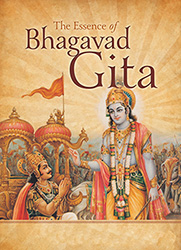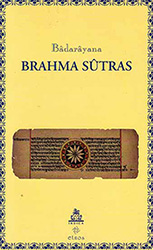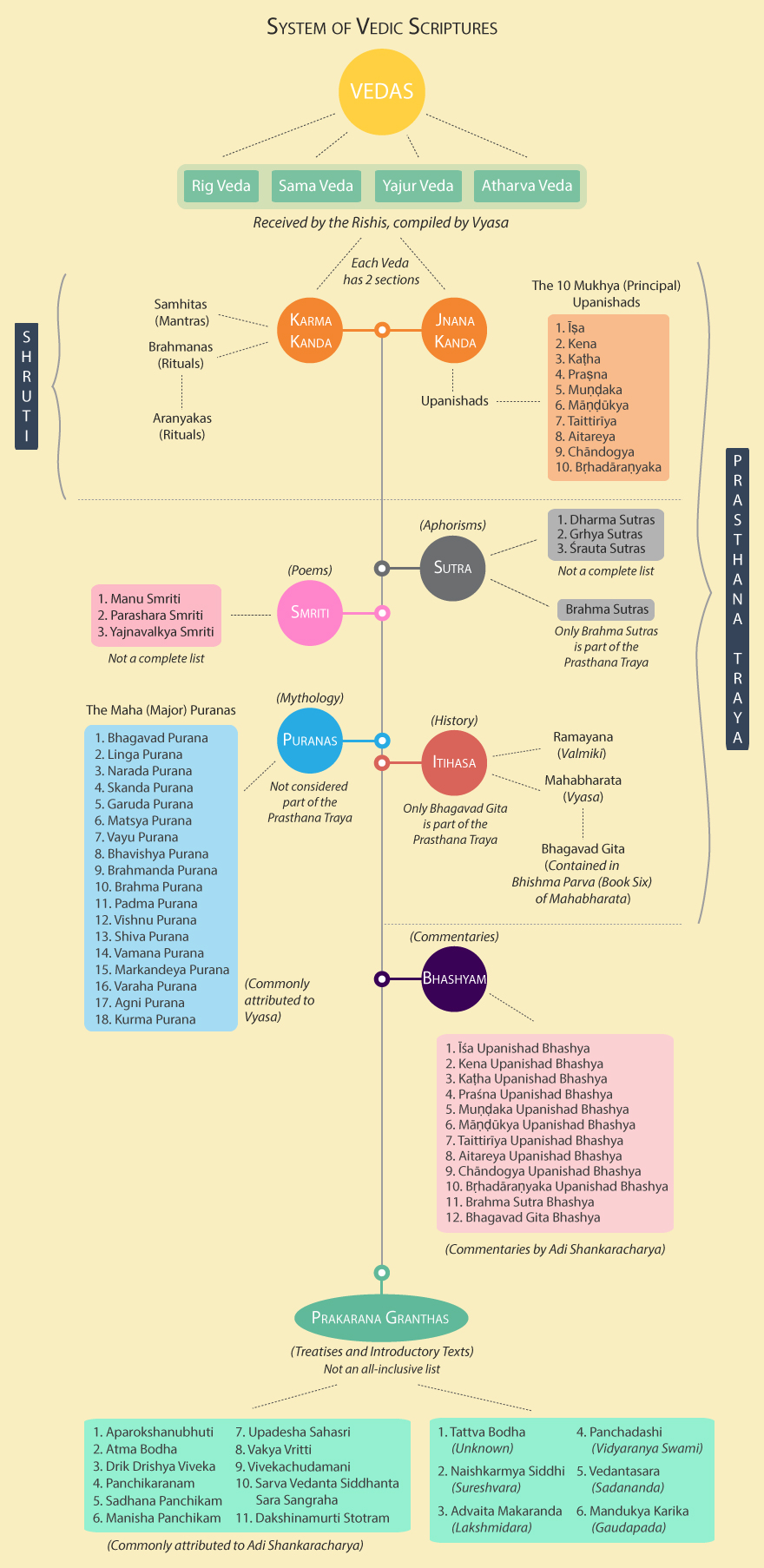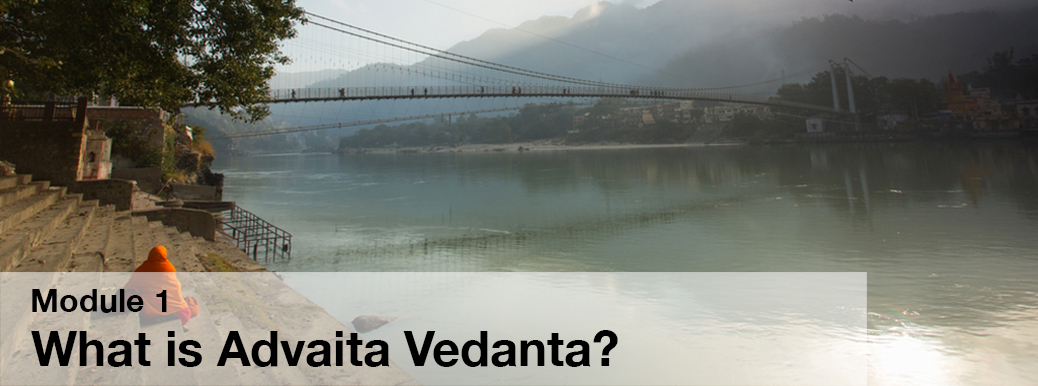Introduction
In this sub-module we’ll define what a scripture is, know the role Vedic scriptures play in the path to liberation, and clear a common misconception about Vedanta.
We’ll also list and explain the 7 layers of scripture which together comprise the vast literature of the Vedas, and the role each layer plays in Vedic teaching tradition.
Definition of Scripture
In his book “Introduction to Vedanta”, Swami Dayananda gives this definition of scripture:
A scripture is a body of knowledge considered divinely authoritative, about matters which cannot be known by the ordinary means of knowledge. The Veda, both the sections, are a means of knowledge for things which cannot be known through a person’s inherent means of knowledge – the five senses supported by the mind.
Spiritual Evolution – The Importance of Karma Kanda
We learnt in the previous chapter that Karma Kanda (Action section) deals with the pursuit of security and pleasure through action (Karma), whereas Jnana Kanda (Knowledge section) is focused on the pursuit of knowledge itself.
However the subject matter of Jnana Kanda is subtle and requires a calm and concentrated mind. So the first section of the Veda, the Karma Kanda, helps us gain such a mind. Various actions (Karma) are mentioned in Karma Kanda which helps one purify his or her mind.
A religious life lived according to Karma Kanda makes one ready to receive the wisdom contained in the Jnana Kanda.
Vedanta is not a Philosophy
If an idea is to be accepted as a fact then it needs to be verified by a legitimate means of knowledge.
But the subject matter of Vedanta, the Self, is not available for direct perception or inference because the Self is more subtle than the human senses and the mind.
When the human senses and the mind can only know objects, how can the Self (which cannot be objectified), the subject, be known through them?
So the subject matter of Vedanta, the Self, cannot be a philosophy.
Philosophies are subject to modification and remain relevant in the world as long as they serve some purpose.
Vedanta, a means of knowledge that works, will never be modified because it already performs its function perfectly.
Nor will it ever become irrelevant or forgotten because the human mind will always need a means to rid itself of its sense of limitation.
The 3 Pillars of Vedanta
The Bhagavad Gita
 The Bhagavad Gita is a part of the great Indian Epic Mahabharata. It contains the teachings that Lord Krishna imparts to Arjuna on the field of battle when Arjuna refuses to fight and do his rightful duty. It has been given the same status as the Upanishads by the tradition.
The Bhagavad Gita is a part of the great Indian Epic Mahabharata. It contains the teachings that Lord Krishna imparts to Arjuna on the field of battle when Arjuna refuses to fight and do his rightful duty. It has been given the same status as the Upanishads by the tradition.
The Bhagavad Gita teaches us on how to apply the teachings of the Upanishads in our day to day life. Any Vedantic study can be said to be incomplete without the study of the Gita. Adi Shankara describes the Bhagavad Gita as the essence of the Vedas.
The Brahma Sutras
 The author of the Brahma Sutras is considered to be Sage Vyasa. There are 555 Sutras (aphorisms) in it. The purpose of the Sutras is to reconcile the seemingly contradictory statements in the Upanishads. Adi Shankara has explained the meanings on the Sutras in his commentaries called the “Bhashya”.
The author of the Brahma Sutras is considered to be Sage Vyasa. There are 555 Sutras (aphorisms) in it. The purpose of the Sutras is to reconcile the seemingly contradictory statements in the Upanishads. Adi Shankara has explained the meanings on the Sutras in his commentaries called the “Bhashya”.
The Brahma Sutras is considered to be a very advanced text.
System of Vedic Scriptures
 We’ll now take a look at the entire range of literature which forms part of Vedic scripture.
We’ll now take a look at the entire range of literature which forms part of Vedic scripture.
The entire scriptural literature derived from the Vedas is called Shastram in Sanskrit. The word Shastram is a compound of two root words: “Shas” and “Tra”.
The root “Shas” has two meanings: one is “to command” and the other is “to teach”. So Shastram means a literature which commands in the initial stages and teaches in the later stages.
The root “Tra” means “to save”. So Shastram is that which saves humanity from its problems by commandment in the initial stages and by enlightenment in the later stages.
Why are there two modes: Commandment and teaching?
There are two modes because when a person is not mature enough the language of commandment and threat is used to direct him to the correct path. And when they have matured, commandments are replaced by teaching, convincing and enlightenment.
The vast Vedic literature can be divided into 7 layers:
1. Vedas
The Vedas are a very vast literature consisting of 20,000+ mantras. It was Vyasa who classified and arranged the Vedas into four parts: Rig Veda, Yajur Veda, Sama Veda and Atharva Veda.
The Rig Veda consists of Rig mantras which are in the form of poetic compositions. Yajur Veda consists of Yajur mantras which are in the form of prose. Sama Veda consists of Sama mantras which are in the form of music. It is said that Indian music is derived from Sama Veda. And lastly Atharva Veda consists of mantras given out by two Rishis: Atharva Rishi and Angiras Rishi.
It is important to note that the word “mantra” is used only for Vedic compositions. The definition of “mantra” in Sanskrit is “Mananat Trayate Iti Mantra”.
Mananat stands for the Sanskrit word “Mananam” which means “analytical study”. Trayate means it will protect us if we inquire into it.
According to our tradition even the mere repetition of the mantras or the meditation on the mantras is capable of helping a person.
So the Vedic compositions are called mantras because they are meant for inquiry, analysis and assimilation.
Origin of the Vedas and Role of Rishis
As was mentioned in the last sub-module, the Vedas were not composed by humans. In our tradition we look upon Vedas as a revelation from God himself.
You can substitute the word God with consciousness if that makes you more comfortable. Both are one and the same. However for the sake of simplicity we’ll use the word God.
So we consider God as the author of the Vedas. However God did not give out the Vedas to humanity directly; he revealed the Vedas through the medium called Rishis.
The word “Rishi” is derived from the Sanskrit root “Rish”, which means “to know”.
These mantras were received by many Rishis. So as an expression of gratitude whenever we chant a Vedic mantra we start by remembering the Rishis.
The Oral Tradition
For a very long time Vedas existed only in an oral form and were not written down. That is why Sanskrit, the language of the Vedas, has no specific script.
The Rishis used to transmit the Vedas to the students orally. There were no books. The entire Vedas was memorized and passed down from one generation to the next orally.
Because of this oral tradition, the Vedas are also knows as Shruti, that which is received by hearing.
So the Vedas form the foremost and primary scriptural literature, and all the subsequent literature is derived from the Vedic foundation.
That is why our culture is called the Vedic culture, and those who follow the Vedas are called Vaidikas. The name “Hindu” was given by the Persians, and no such word exists in the Vedas.
2. Sutra Literature
Sutras existed at a time when the oral tradition was still the only mode of transferring the knowledge from one generation to the next. So to make it easier to commit the knowledge to memory, Sutras were kept very short and tight, but packed a lot of knowledge within.
The function of Sutras in Vedic teaching is two:
- Codification
- Clarification
Codification
Codification refers to classification and re-arrangement based on topics.
In the Vedas the diverse topics are not arranged in an organized manner. So in the Sutras ideas are culled from various places in the Vedas and presented topic wise.
Sutras are a topical classification to help understand the knowledge of the Vedas.
For e.g. there is the Dharma Sutra which deals with teachings on individual values, duties and responsibilities. Grihya Sutra deals with family values and responsibilities. Shrauta Sutra deals with activities related to the welfare of the entire society.
From Vedanta’s point of view the most important Sutra is the Brahma Sutras which is attributed to Badarayana. In Brahma Sutra the vision of Vedanta is defended against the views of other schools of thoughts.
Every school of thought has its own ideas about what is the truth, what is Moksha, what is God, the reality of the world etc. Basically they are dualists. So the Brahma Sutra points out the fallacies in their arguments and logically explains why Vedanta is correct.
Whereas the Vedas are supposed to be authored by God, the Sutras are a product of human intellect. They were written by various Rishis. The words belong to the Rishis, but the content is borrowed from the Vedas.
Clarification
The 2nd function of Sutras is clarification. If there are vague or seemingly contradictory statements in the Vedas then the Sutras will clarify them.
The word “sutra” itself has one of its meanings as “thread”. The Sutra literature is called a thread because it threads the topics contained in the Vedas.
A beautiful illustration for Sutras is given in the tradition: The knowledge contained in the Vedas are like loose flowers strewn all over the place. The Sutras is the thread which collects the flowers and presents them in the form of a beautiful garland.
3. Smriti Literature
The Rishis having studied the Vedas (Shruti) and arranged them topically in Sutras, the knowledge is then presented in a more elaborate form in Smriti literature.
The function of Smritis is also codification and clarification.
Thousands of verses have been written by various Rishis which form part of Smriti literature. For e.g. Manu Smriti, Parashara Smriti, Yajnavalkya Smriti etc.
The difference between Sutras and Smritis is that Sutras being very concise can be cryptic and vague, whereas in Smriti the topics are explained in a more elaborate fashion.
In Sutra literature many ideas are hidden. These ideas are brought out and made clearer in Smritis.
4. The Puranas
Puranas are also in the form of poems. Their job is also codification and clarification, but the teaching is in an even more expanded form compared to the Smritis.
In Puranas the ideas and knowledge of Vedas is presented in the form of stories. A single value from the Veda would be presented as a story of thousand plus verses.
For e.g. the entire Harishchandra Purana is based on one value – to speak the truth.
Also many ideas are personified as characters in the stories. For e.g. in Bhagavata Purana desire, anger and egoism are personified as demons.
So through the medium of stories and through personificating values – both good and bad – Puranas try to instill the knowledge of Vedas in us.
Most of the Puranas was written by Vyasa, the compiler of Vedas. There are 18 Maha Puranas (Major Puranas) and 18 Upa Puranas (Secondary Puranas).
Both types of Puranas consist of thousands of verses. Bhagavata Purana is the most popular Purana.
5. Itihasa Literature
The word Itihasa is a compound of several root words: “Iti” meaning “this” or “in this way”, “ha” meaning “definitely” and “Asa” which means “it occurred”, “happened” or “took place”.
So the contents of Itihasa are supposed to be based on what really happened. Even in the Puranas many stories are supposed to be based on actual events.
The Itihasa literature is also in the form of poems. The two main Itihasas are: (a) Ramayana written by Valmiki consisting of 24,000 verses. (b) Mahabharata written by Vyasa consisting of around 100,000 verses. Bhagavad Gita is part of Mahabharata.
Ramayana is the story of Rama who is considered to be an avatar of Vishnu. Through Ramayana Rama is presented as a model of Vedic way of living, one who always follows Dharma irrespective of his wishes.
Mahabharata is the story of the descendants of Bharata. In fact “Bharat” is one of the official names of India named after him. And the word “Maha” in Mahabharata stands for vast literature.
So in Itihasa literature Vedic teachings are presented through the stories of Ramayana and Mahabharata.
One important thing to note is that the primary purpose of Itihasa is not to present history exactly as it happened; the primary purpose is Vedic teaching. So in some cases fiction is mixed with fact to emphasize certain ideas.
For e.g. in Ramayana the main villain Ravana has ten heads. The ten heads represent 10 different aspects of Ravana’s personality.
6. Bhashyam Literature
Commentaries are required because the knowledge in the scriptures has to be extracted in a proper manner. If you do not understand the real meaning behind the words of scripture you’ll find seeming contradictions or develop wrong understanding. The key to unlocking the knowledge lies with the Sampradaya, the tradition.
That is why it is not recommended to learn Vedic knowledge from someone who has himself not studied within the tradition. That person will never be able to explain the true meaning behind the words of the Vedas.
So with the help of the Sampradaya various Acharyas (Teachers) have written commentaries to explain the teachings of the Vedas. The commentaries are normally in the form of prose of verse.
7. Prakarana Granthas
Whereas Bhasyam literature focuses on only one text, for e.g. an Upanishad or a Sutra, Prakarana Granthas source their information from various Vedantic texts and present a complete teaching on a topic.
There are 2 types of Prakarana Granthas:
So all these 7 layers together constitute the vast scriptural literature called Shastram. The Upanishads, Brahma Sutras and the Bhagavad Gita are together called Prasthana Traya which literally means “3 sources”.
Summary
| 1. | Scripture is defined as a body of knowledge for something which cannot be known through ordinary means of knowledge. |
| 2. | Karma Kanda helps one purify his or her mind for the study and contemplation of Vedanta. |
| 3. | Vedanta is not a philosophy or a school of thought. |
| 4. | There are 3 pillars of Vedanta: Upanishads, Bhagavad Gita and Bramha Sutras. Together they are also called Prasthana Traya which literally means “3 sources”. |
| 5. | The entire scriptural literature derived from the Vedas is called Shastram, and the entire literature can be divided into 7 layers. |
| 6. | The 1st layer is the Vedas which were compiled by Vyasa. There are 4 Vedas: Rig Veda, Yajur Veda, Sama Veda and Atharva Veda. |
| 7. | The Vedas are considered as revelations from God or Consciousness, they were not written by humans. Vedas are the primary scriptures of Hinduism. |
| 8. | For thousands of years the Vedas were passed from one generation to the next orally. Which is why Vedas are also known as Shruti, that which is heard. |
| 9. | The 2nd layer is Sutra literature. Sutras are aphorisms, short concise statements which contain a lot of ideas. The function of Sutras is codification and clarification of Vedic ideas. |
| 10. | The most important Sutra from Vedantic point of view is Brahma Sutras. |
| 11. | The 3rd layer is Smriti literature which is generally in the form of poems. The function of Smriti literature is also codification and clarification, but it is in a more expanded form than the Sutras. |
| 12. | The 4th layer is Puranas, which are also in the form of poems. In Puranas the ideas and knowledge of Vedas is presented in the form of stories. |
| 13. | The 5th layer is Itihasa which means “history” which are also in the form of poems. Ramayana and Mahabharata are the two main Itihasas. The purpose of Itihasas is to present Vedic teachings in the form of stories. |
| 14. | The 6th layer is Bhasyam literature which refers to commentaries written on the preceding 5 layers. |
| 15. | The 7th and last layer is called Prakarana Granthas which are treatises and introductory texts written by various teachers to explain the teachings of Vedanta. |


